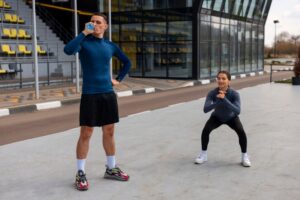Unveiling Advanced Performance fabrics: A Deep Dive into Sportswear Material Innovation

Table of Contents
ToggleIn an era where sportswear is no longer limited to basic attire, innovative materials have ushered in a new age of athletic performance and comfort. From moisture-wicking fabrics to breathable membranes and advanced insulation, the sportswear industry has seen a remarkable transformation. This article takes an in-depth look at these cutting-edge advancements, exploring their applications and benefits across various weather conditions and physical activities.
A) sportswear Moisture-Wicking material: Elevating Comfort and Performance Innovation
Moisture-wicking fabrics have emerged as a cornerstone of modern sportswear innovation, revolutionizing the way athletes experience comfort and performance. Unlike conventional fabrics, which tend to trap moisture and lead to discomfort during physical activities, moisture-wicking textiles offer a groundbreaking solution to the age-old problem of sweat accumulation. These fabrics are engineered with advanced technology that actively manages moisture, ensuring athletes stay dry, comfortable, and focused on their goals. This section takes a comprehensive look at the significance of moisture-wicking fabrics, delving into their scientific underpinnings and the myriad benefits they bring to the world of sports.
1. Moisture-Wicking Magic: The Science Behind Dry Comfort
Traditional fabrics, while often comfortable in everyday settings, fall short when it comes to addressing the specific needs of athletes. Moisture-wicking fabrics, on the other hand, harness scientific principles to provide an elevated level of comfort during physical exertion. The underlying technology revolves around capillary action, which is the ability of a liquid to flow in narrow spaces without the assistance of, or against, external forces like gravity. In the context of sportswear, this means that these fabrics can effectively pull moisture away from the skin, promoting rapid evaporation and leaving athletes feeling dry and comfortable.
2. Differentiation from Traditional Materials
The distinction between moisture-wicking fabrics and traditional materials is stark. Conventional fabrics like cotton tend to absorb moisture, causing discomfort and hindering performance. Moisture-wicking textiles, however, work actively to transport moisture away from the skin’s surface. This crucial difference transforms the sportswear experience, enabling athletes to remain focused on their activities without the distraction of damp, clingy clothing.
3. Capillary Action: The Driving Force
At the heart of moisture-wicking fabrics lies capillary action. This phenomenon is driven by the interaction between the fabric’s fibers and moisture. As sweat accumulates on the skin, the fabric’s capillaries, or tiny channels between the fibers, act as conduits, pulling the moisture inward. Once absorbed, the moisture spreads out across a larger surface area of the fabric, facilitating rapid evaporation. This natural process keeps athletes dry, regulates body temperature, and prevents discomfort caused by prolonged exposure to dampness.

4. Faster Evaporation: The Key to Comfort
The rapid evaporation facilitated by moisture-wicking fabrics is a game-changer. By expelling moisture quickly, these fabrics mitigate the adverse effects of prolonged sweat exposure. Athletes experience reduced friction between their clothing and skin, minimizing the risk of chafing and irritation. Moreover, moisture-wicking technology enhances temperature regulation. As the body heats up during exercise, the fabric’s ability to wick away moisture prevents overheating. Conversely, in colder conditions, the absence of moisture on the skin reduces the risk of chilling. Additionally, the inhibition of odor-causing bacteria growth ensures that sportswear stays fresher for longer periods, contributing to overall comfort and confidence.
5. Unleashing Performance Through Dryness
Perhaps the most significant advantage of moisture-wicking fabrics is their ability to enhance athletes’ performance. By eliminating the discomfort caused by sweat accumulation, these fabrics create an environment where athletes can focus entirely on their training and competition. The removal of distractions and irritations translates to improved concentration, enabling athletes to reach their full potential. In a competitive landscape where every edge matters, moisture-wicking fabrics stand out as a fundamental tool for elevating comfort and, consequently, performance.
B) Breathable Membranes: The Science of Ventilation
In the dynamic world of sportswear innovation, breathable membranes have emerged as a breakthrough technology that not only shields athletes from external elements but also maintains optimal ventilation. This section delves into the captivating realm of breathable membranes, unveiling the intricate science behind their creation and operation. As the perfect harmony between protection and breathability, these membranes have revolutionized the way athletes engage with their surroundings during physical activities.
1. The Microscopic Pores: Balancing Airflow and Protection
At the core of breathable membranes lies an ingenious design element – microscopic pores that are carefully engineered to strike a delicate balance between airflow and protection. These pores are minuscule enough to prevent the ingress of larger water droplets, yet large enough to allow the passage of moisture vapor and air. This unique characteristic enables the membrane to act as a barrier against external elements, such as rain and wind, while simultaneously facilitating the exchange of air and vapor, ensuring athletes remain comfortable.
2. Shielding from the Elements: A Breathable Barrier
The hallmark of breathable membranes is their ability to shield athletes from the unpredictable forces of nature while permitting air circulation. This duality is achieved through a combination of advanced materials and engineering. When rain or wind encounters the breathable membrane, the tiny pores prevent the entry of larger water droplets, effectively repelling water while maintaining the material’s breathability. This protective shield ensures that athletes stay dry and comfortable, even in inclement weather conditions.
3. Intelligent Design: Adapting to Exertion, Temperature, and Humidity
One of the most remarkable aspects of breathable membranes is their ability to adapt intelligently to changing conditions. The breathability of these membranes is not a fixed trait but a dynamic response to variables such as physical exertion, temperature, and humidity. During high-intensity activities that generate substantial heat and sweat, the pores enlarge, allowing greater airflow and moisture vapor to escape. Conversely, in cooler conditions, the pores contract to retain warmth while still enabling the essential exchange of air.

4. All-Day Comfort: Navigating Prolonged Activities
The comfort provided by breathable membranes extends beyond short bursts of physical activity. Their ability to maintain a balanced microclimate within sportswear ensures that athletes can engage in prolonged activities without the discomfort of excessive moisture accumulation. By regulating the exchange of air and vapor, these membranes prevent the buildup of heat and humidity, resulting in a comfortable experience, even during extended sessions.
5. Weather-Ready: Defying Rain and Wind While Allowing Moisture to Escape
Breathable membranes are uniquely equipped to handle variable weather conditions. In rainy weather, the pores efficiently repel water, keeping athletes dry. Simultaneously, the escape of moisture vapor through the pores ensures that sweat does not accumulate on the skin. In windy conditions, the barrier prevents wind chill from penetrating the fabric while permitting air exchange to maintain a balanced microclimate. This versatility makes breathable membranes an indispensable asset for athletes who train or compete in diverse weather environments.
6. Dynamic Adaptation: Keeping Athletes Comfortable in Changing Environments
Perhaps one of the most exciting features of breathable membranes is their ability to adapt on the fly. The membranes respond in real-time to the athlete’s needs, dynamically adjusting their breathability to match the level of physical exertion and prevailing environmental conditions. This adaptability not only enhances comfort but also contributes to optimal performance, allowing athletes to focus on their goals without the distraction of discomfort.
C) Advanced Insulation: Conquering Diverse Weather Challenges
In the pursuit of optimal athletic performance, staying comfortable across a spectrum of weather conditions is a crucial factor. Enter advanced insulation materials, a revolutionary solution that has transformed the way athletes tackle varying climatic challenges. This section delves into the realm of advanced insulation, highlighting its role in providing the perfect balance between warmth, mobility, and adaptability – a combination that empowers athletes to conquer even the most demanding weather scenarios.

1. Beyond the Basics: Insulation for Every Condition
The quest for insulation that delivers both warmth and mobility has been a persistent challenge in sportswear design. Advanced insulation materials have emerged as the answer, redefining the standards of protection and comfort. Unlike traditional insulating fabrics that often result in bulkiness, these modern materials offer tailored warmth that doesn’t compromise athletes’ freedom of movement. Whether it’s facing icy winds or tackling frigid temperatures, advanced insulation ensures athletes stay comfortable without sacrificing performance.
2. Tailored Warmth: Providing Insulation in Every Climate
The cornerstone of advanced insulation lies in its ability to provide effective warmth retention without adding bulk. Traditional insulating materials were often thick and restrictive, hindering athletes’ agility. Advanced insulation, on the other hand, leverages innovative engineering to trap body heat within microscopically designed pockets. This design ensures that athletes can maintain their optimal body temperature, even in colder conditions, while enjoying unrestricted movement.
3. Regulating Heat: Allowing Excess Warmth and Moisture to Dissipate
In high-performance sportswear, regulating body heat is a critical factor. Advanced insulation materials are designed not only to retain warmth but also to facilitate the dissipation of excess heat and moisture. As athletes engage in intense physical activities, they generate heat and sweat. Advanced insulation manages this by allowing excess warmth and moisture to escape, thereby preventing overheating and ensuring a comfortable experience.
4. Streamlined Freedom: Lightweight Insulation for Unrestricted Movement
The bulkiness of traditional insulation often hindered athletes’ natural range of motion. Advanced insulation materials address this limitation by offering warmth without adding unnecessary weight or volume. This streamlined design empowers athletes to move freely, enabling them to perform at their best without the encumbrance of heavy layers. The result is a sportswear solution that seamlessly integrates warmth and mobility.
5. Versatility Redefined: Adaptable Systems for Varying Weather Scenarios
Athletes often find themselves navigating changing weather conditions. Advanced insulation tackles this challenge by incorporating adaptable systems. Some sportswear designs feature modular insulation components that can be added or removed as needed. This level of customization allows athletes to adjust their attire to match the specific demands of the environment, ensuring they stay comfortable and ready to perform, regardless of the weather.
D) The Sustainability Aspect: Eco-Friendly Innovations
In the pursuit of optimal athletic performance, staying comfortable across a spectrum of weather conditions is a crucial factor. Enter advanced insulation materials, a revolutionary solution that has transformed the way athletes tackle varying climatic challenges. This section delves into the realm of advanced insulation, highlighting its role in providing the perfect balance between warmth, mobility, and adaptability – a combination that empowers athletes to conquer even the most demanding weather scenarios.
1. Beyond the Basics: Insulation for Every Condition
The quest for insulation that delivers both warmth and mobility has been a persistent challenge in sportswear design. Advanced insulation materials have emerged as the answer, redefining the standards of protection and comfort. Unlike traditional insulating fabrics that often result in bulkiness, these modern materials offer tailored warmth that doesn’t compromise athletes’ freedom of movement. Whether it’s facing icy winds or tackling frigid temperatures, advanced insulation ensures athletes stay comfortable without sacrificing performance.
2. Tailored Warmth: Providing Insulation in Every Climate
The cornerstone of advanced insulation lies in its ability to provide effective warmth retention without adding bulk. Traditional insulating materials were often thick and restrictive, hindering athletes’ agility. Advanced insulation, on the other hand, leverages innovative engineering to trap body heat within microscopically designed pockets. This design ensures that athletes can maintain their optimal body temperature, even in colder conditions, while enjoying unrestricted movement.

3. Regulating Heat: Allowing Excess Warmth and Moisture to Dissipate
In high-performance sportswear, regulating body heat is a critical factor. Advanced insulation materials are designed not only to retain warmth but also to facilitate the dissipation of excess heat and moisture. As athletes engage in intense physical activities, they generate heat and sweat. Advanced insulation manages this by allowing excess warmth and moisture to escape, thereby preventing overheating and ensuring a comfortable experience.
4. Streamlined Freedom: Lightweight Insulation for Unrestricted Movement
The bulkiness of traditional insulation often hindered athletes’ natural range of motion. Advanced insulation materials address this limitation by offering warmth without adding unnecessary weight or volume. This streamlined design empowers athletes to move freely, enabling them to perform at their best without the encumbrance of heavy layers. The result is a sportswear solution that seamlessly integrates warmth and mobility.
5. Versatility Redefined: Adaptable Systems for Varying Weather Scenarios
Athletes often find themselves navigating changing weather conditions. Advanced insulation tackles this challenge by incorporating adaptable systems. Some sportswear designs feature modular insulation components that can be added or removed as needed. This level of customization allows athletes to adjust their attire to match the specific demands of the environment, ensuring they stay comfortable and ready to perform, regardless of the weather.
Conclusion
The future of sportswear innovation is a promising blend of comfort, performance, and sustainability. It transcends fabric, embodying science, engineering, and environmental consciousness. Athletes will experience moisture-wicking fabrics, adaptable breathable membranes, and advanced insulation, ensuring peak performance across climates.
Sustainability stands at the forefront of this future, with waste reduction, resource repurposing, and eco-friendly practices. Biodegradable fabrics, low-impact dyeing, and durable designs forge a circular economy, minimizing the industry’s ecological impact.
This future redefines consumer choices. Environmental awareness reshapes expectations, fostering a partnership for positive change. Here, sportswear symbolizes ingenuity, adaptability, and sustainable commitment. Comfort, performance, and sustainability coalesce, ushering in an era where excellence and environmental consciousness harmonize seamlessly. In this evolving journey, sportswear embodies not just who we are, but who we aspire to be.






Pingback: Mastering Sports Performance: Choosing the Right Sportswear for Super Players in 2024